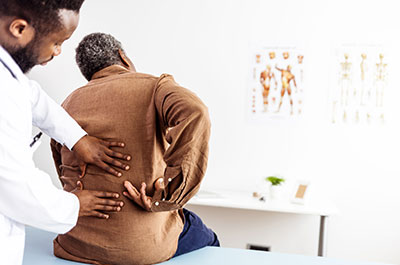With around-the-clock access to smartphones, laptops, tablets and gaming devices, more Americans than ever before are hunching over screens. Yet, our bodies are not designed to spend so much time looking down. All of that screen time often results in neck pain that experts call “tech neck.”
“When people look down at cell phones, laptops or tablets, the natural forward curvature in the cervical spine is reversed,” says Clifford Houseman, D.O., an neurosurgeon at Henry Ford Health. "Over time, that constant forward bending motion reduces mobility and causes pain in the neck, back and shoulders."
What Is Tech Neck?

Spine Care At Henry Ford
The natural curvature (lordosis) in our neck is designed to take the weight of our 10- to 12-pound head and place it over structures of the spine designed to support it. Looking down puts the weight of your head over the individual discs of the spine in your neck. It also places tremendous stress on the muscles in the neck and shoulders.
“The discs are not designed to support constant pressure. Over time, they will begin to break down, resulting in early degenerative changes, early arthritis, pain and stiffness,” says Dr. Houseman.
Looking down can even cause the neck's natural curvature to point in the wrong direction. This puts even more stress and strain on the neck, shoulders and spine. And while exercise can help, the only way to alleviate tech neck is to ensure you carry yourself correctly as often as possible — and that means not looking down.
Here, Dr. Houseman offers simple strategies to prevent — and treat — damage caused by tech neck.
Correcting Poor Neck Posture
- Sit tall: “Most people sit in the middle of their chairs and lean forward to their desks,” says Dr. Houseman. A better option: Scooch your buttocks all the way to the back of the chair. Sit with your hips and knees at a 90-degree angle. This supports your low back. Place your screen at eye level, 18 to 25 inches away from your face. This discourages slouching and supports your head.
- Find support: Lumbar supports, head rests, functional garments (with special material designed to help you sit straighter), neck pillows and other tools can help straighten out your spine and make it more difficult for you to slouch.
- Take a break: Limit the time you spend sitting (or standing) in the same position, especially if you’re spending much of that time looking down. Dr. Houseman's advice: Get up and move as much as possible, at least every hour. Go for a walk. Climb a flight of stairs or just stand up and stretch.
- Stretch it out: If you have tech neck already, don’t fret. There are plenty of things you can do restore the curvature in your spine and loosen up your neck, back and shoulder muscles. Your provider can help you explore treatment options and show you tailored exercises and stretches.
Reviewed by Dr. Clifford Houseman, a neurosurgeon who sees patients at Henry Ford Michigan Spine & Brain Surgeons in Novi, Southfield and Warren.



